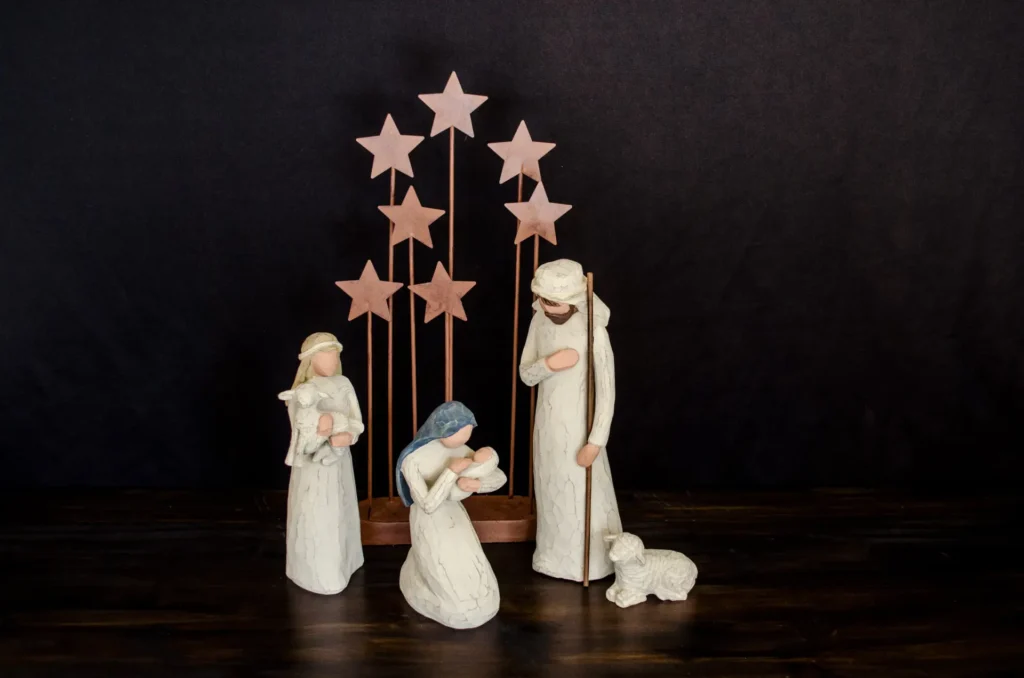Introduction
As we gather for this festive season our homes are filled with the warmth of family, perhaps surrounded by children and grandchildren. The Christmas tree stands adorned with twinkling lights, its branches sheltering a collection of brightly wrapped packages. Laughter, good food, and festive fun are the order of the day. Yet, amidst these delightful traditions, there exists a gift far more profound than anything nestled under the tree. It’s the gift of God’s own Son, the God of creation who chose to come to earth as a baby and lay in a manger.
Christmas is a time for reflection and joy, celebrating this momentous gift. Over two millennia ago, in a humble town called Bethlehem, the world witnessed the fulfillment of God’s promise of salvation and the manifestation of divine love and grace. Luke 2:4-7 paints this picture vividly:
This scene, marked by simplicity and humility, starkly contrasts the profound significance of the birth of Jesus Christ – that He came to earth to die for the sins of men (1 Corinthians 15:3-4)
Complementing this account, the Gospel of Matthew provides additional insight, focusing on the fulfillment of Old Testament prophecies and the visit of the Magi. Matthew 1:22-23 reveals,
This emphasize on fulfillment of scripture and miraculous nature of Jesus’ birth confirm His identity as the Son of God.
Today, as we celebrate Christmas, it’s not just about the festive atmosphere or the gifts we exchange. It’s a time to revisit and cherish the sacred event of Jesus’ birth. It reminds us of the unparalleled love of God, who sent His Son into the world, starting a journey that would ultimately lead to humanity’s redemption. In this celebration lies the true gift of Christmas: the gift of God’s Son, a beacon of hope and salvation.
The Historical and Biblical Account of Jesus’ Birth
The story of Jesus’ birth unfolds in a setting marked by simplicity and humility, yet it is laden with deep significance. The Gospels of Luke and Matthew provide us with detailed accounts that not only narrate the event but also place it within its historical and socio-political context.

Luke 2:1-7 takes us to the heart of the story.
Joseph, a carpenter, and Mary, his wife, traveled from Nazareth to Bethlehem, the city of David (since Joseph was from that family line), to comply with this decree. The journey was not an easy one, especially with Mary in the late stages of her pregnancy.
Ostracization and Contempt
Mary’s life, as an unwed woman expecting a child in her time, was fraught with considerable risks and social challenges. During the period in which Mary lived, Jewish society adhered strictly to religious and moral codes. An unwed woman found to be pregnant faced severe social stigma, and the consequences could range from being ostracized by the community to, in the most extreme cases, facing the penalty of death by stoning as per the laws of the time (Deuteronomy 22:20-21). This societal backdrop meant that Mary’s pregnancy, which occurred before her formal union with Joseph, put her in a precarious and potentially dangerous position.
Joseph’s initial response, as described in Matthew 1:19, reflects the societal norms and the dilemma he faced: “Because Joseph her husband was faithful to the law, and yet did not want to expose her to public disgrace, he had in mind to divorce her quietly.” This indicates that Joseph, aware of the risks and stigma Mary faced, contemplated quietly ending their betrothal to spare her public humiliation. However, Joseph’s decision to stay with Mary and marry her, guided by divine intervention (Matthew 1:20-24), was itself an act of great courage and defiance of societal norms.
By choosing to marry Mary, Joseph not only accepted her and the unborn Jesus but also likely faced ostracization and suspicion from the community. This decision positioned both Mary and Joseph as social outliers, challenging the expectations and norms of their time. Their experience underscores themes of faith, resilience, and the strength to stand against societal judgment, emblematic of the broader message of the Christmas story. Mary and Joseph’s journey, marked by faith and courage in the face of daunting social challenges, is a testament to their unwavering trust in God’s plan, despite the personal risks and societal repercussions they endured.
Upon arrival, they found no lodging available. It was in these humble circumstances that Mary gave birth to Jesus. “She wrapped him in cloths and placed him in a manger, because there was no guest room available for them.” (Luke 2:7) This scene, devoid of grandeur, marks a stark contrast to the significance of Jesus’ birth. The angel had told Mary that he was the long awaited Messiah and would save his people from their sins.
Matthew 1:18-25 offers additional insights, focusing on the divine nature of this birth. “This is how the birth of Jesus the Messiah came about: His mother Mary was pledged to be married to Joseph, but before they came together, she was found to be pregnant through the Holy Spirit.” The birth of Jesus to a virgin, as foretold by prophets, signifies a miraculous intervention by God. Joseph’s decision to take Mary as his wife, despite the initial shock and the probably ostracization he faced, demonstrates his faith and obedience to God’s plan.
The socio-political environment during the time of Jesus’ birth was complex and multi-layered. On one hand, there was the overarching presence of Roman rule, which imposed its own order and authority over the Jewish people. On the other hand, within Jewish society itself, there was a deep-seated anticipation of a Messiah. This Messiah, many believed, would be a powerful leader who would deliver them from Roman oppression and restore the kingdom of Israel to its former glory. Against this backdrop, the actual circumstances of Jesus’ birth stand in stark contrast to the prevailing expectations.
Jesus was born to a young, poor couple, not in a palace or a place of prominence, but in a humble setting—laid to rest in a manger in the small town of Bethlehem. This aspect of the Christmas story is profound in message God chose to send. It demonstrates His choice to manifest Himself not through power and majesty, but through humility, simplicity and ultimately servitude. This subversion of contemporary expectations for a savior is critical to understanding the essence of Jesus’ mission on Earth.
His life was not one marked by earthly power or political dominance, but rather by love, humility, and service. From the very circumstances of His birth, Jesus’ journey was one that challenged societal norms and expectations. It was a path that would ultimately lead to His ultimate act of love and sacrifice—His death and resurrection for the redemption of humanity. This journey, beginning in the most humble of settings, sets the stage for a deeper appreciation of the Christmas message and the profound nature of Jesus’ mission.
The Theological Significance
The birth of Jesus Christ holds deep theological significance, chiefly seen in the fulfillment of Old Testament prophecies and the profound mystery of the incarnation. These aspects are central to understanding the faith in Christ and the nature of Jesus as both fully divine and fully human.
The Old Testament contains several prophecies about the coming Messiah, which Jesus fulfilled. Isaiah 7:14 is a cornerstone prophecy, stating,
This prophecy, written centuries before Jesus’ birth, underscores the miraculous nature of his conception and his identity as ‘God with us.’

Another significant prophecy is found in Micah 5:2, which foretells the Messiah’s birthplace:
The fulfillment of this prophecy in Jesus’ birth in Bethlehem is a testament to the precision and reliability of biblical prophecy.
The incarnation, God becoming man in Jesus Christ, is a central tenet of Christian theology. This concept is crucial because it bridges the infinite gap between God and humanity. By taking on human flesh, Jesus embodies the perfect union of divinity and humanity. This union is essential for the redemption of humanity, as Jesus, being without sin, was the only one capable of paying the ultimate price for the sins of mankind.
The Apostle Paul reflects on this mystery in Philippians 2:6-8, stating:
Imagine that the Creator of everything became part of creation. God’s own Son came to earth and took on human form. It is almost too much to comprehend. 1 John 4:9-10 tells us why:
Thus, the birth of Jesus is more than a historical event; it is the manifestation of God’s plan for salvation, a plan that has been unfolding since the beginning of time (Revelation 13:8). The theological significance of this event lies in its affirmation of Jesus as the Messiah, the fulfillment of ancient prophecies, and the living bridge between God and man, opening the way for redemption and reconciliation.
Contemporary Reflections and Applications
The story of Christ’s birth, steeped in humility and simplicity, provides enduring lessons for Christians today. These aspects of Jesus’ early life are not just historical details but serve as powerful teachings on faith, humility, and service.
The humility of Christ’s birth is striking. Born in a manger, in a small town, to a modest family, Jesus’ beginnings were far from royal or grandiose. This humble start sets a profound example for believers. Philippians 2:3-4 advises:
Jesus’ humble birth becomes a model for how Christians are called to live – prioritizing others, serving with a humble heart, and finding strength in simplicity.

Furthermore, the simplicity of the nativity scene contrasts sharply with today’s often materialistic and busy lifestyle. It serves as a reminder to focus on what truly matters – faith, family, and emulating Jesus in our lives. In a world filled with distractions and complexities, the simplicity of Christ’s birth encourages believers to seek a life that is humble, selfless and desires to honor our savior.
The universal message of love and redemption, central to the Christmas story, remains relevant and powerful. John 3:16 encapsulates this message;
This verse highlights the depth of God’s love for humanity and the purpose of Jesus’ life and death – to offer redemption and eternal life to all who believe.
The circumstances of Jesus’ birth – humble, simple, yet filled with divine purpose – offer Christians today a path to follow. They teach the value of humility, the importance of a life focused on spiritual riches rather than material ones and remind believers of the immense love and redemption available through faith in Christ. These lessons from over two millennia ago continue to resonate and guide in the contemporary Christian journey.
Conclusion
The enduring legacy of Christ’s birth is a tapestry of deep theological significance, humble beginnings, and a universal message of love and redemption. This legacy, rooted in the fulfillment of ancient prophecies and the miraculous nature of the incarnation, continues to resonate with believers around the world.
As we reflect on the story of Jesus’ birth on Christmas day, it offers more than historical insight; it provides a living example of the values central to the Christian faith. The humility and simplicity of Jesus’ nativity teach us about the essence of true servanthood and the importance of prioritizing spiritual over material wealth. His birth, a manifestation of God’s profound love for humanity, invites us to embrace this love and extend it to others.
As we celebrate Christmas, it is an opportunity to rediscover and connect with these core principles. Whether in personal reflection or in community celebrations, the Christmas story beckons us to delve deeper into our faith. It encourages us to emulate the humility of Christ, to cherish the simplicity of his birth, and to live out the message of love and redemption he brought into the world.
Let this Christmas be more than a seasonal celebration; let it be a time to renew our commitment to Jesus, to find joy in the simplicity of faith, and to spread the message of hope and love that his birth represents.
Learn more, take your faith further:




